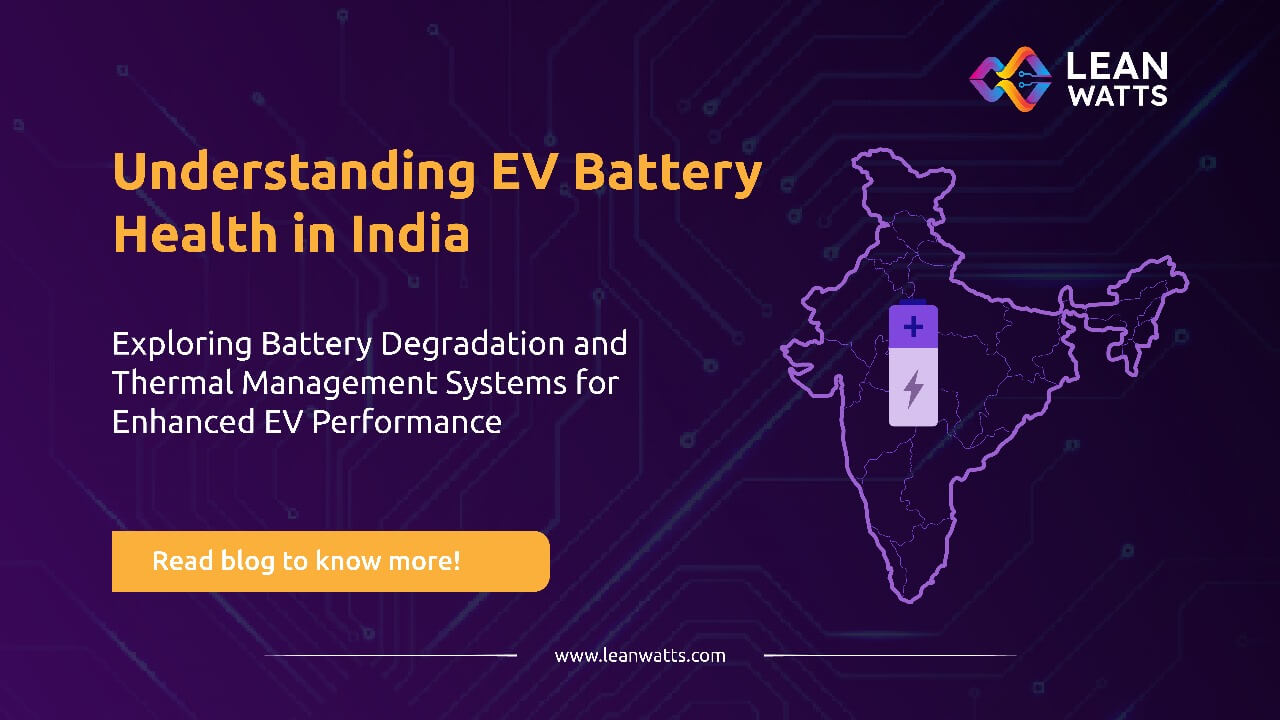
Exploring Battery Degradation and Thermal Management Systems for Enhanced EV Performance
Introduction
As electric vehicles (EVs) gain traction in India, understanding battery health is essential for consumers, manufacturers, and policymakers alike. The country’s unique climate—with high temperatures, humidity, and challenging driving conditions—accelerates EV battery degradation, reducing performance and lifespan. This article delves into the key factors impacting EV battery degradation in India, emphasising the role of thermal management systems in mitigating these issues. It also examines Indian policy initiatives like FAME II, which promotes innovations to tackle degradation and provides practical tips for EV owners to maintain battery health.
1. Causes of EV Battery Degradation
EV batteries are primarily lithium-ion batteries, known for high energy density but also susceptible to degradation over time. Here’s a look at the main factors driving battery wear and tear:
Heat and Temperature Sensitivity
High temperatures are one of the leading causes of battery degradation, especially in a warm climate like India’s. Lithium-ion batteries are sensitive to heat, which accelerates the chemical reactions inside the battery, increasing degradation rates. This results in lower charging efficiency, reduced battery capacity, and a shorter overall lifespan.
Heavy Usage and Rapid Charging
Frequent fast charging, common in urban settings where drivers seek quick recharges, can raise battery temperatures and stress the cells, speeding up degradation. Additionally, heavy loads and extended usage—such as driving with full passenger loads or carrying goods in high temperatures—further strain the battery, particularly in Indian cities where traffic is dense and driving conditions are demanding.
Voltage Cycling
Voltage cycling, the process of repeatedly charging and discharging a battery, naturally reduces a battery’s efficiency over time. In Indian EV applications, which often require frequent stops and starts, this cycling happens more frequently, adding another layer of wear and tear on the battery’s health.
2. Role of Thermal Management Systems in Battery Health
Thermal management systems are crucial for maintaining optimal battery temperature and improving battery longevity. Here’s how these systems help mitigate the impacts of extreme climates and heavy usage on EV batteries:
Passive Cooling Systems
Passive cooling systems rely on materials and design to naturally dissipate heat. For instance, using thermally conductive materials in the battery pack design allows heat to spread evenly, reducing temperature spikes. While passive cooling is effective in moderate climates, its limitations become apparent in India’s hotter regions, making active cooling systems necessary.
Active Cooling Systems
Active cooling systems are more advanced and better suited for India’s climate. These systems use liquid or air cooling to regulate temperature, drawing heat away from the battery cells during operation and charging. By maintaining a stable temperature, active cooling minimises thermal-related degradation, even during demanding conditions.
- Liquid Cooling: Liquid-cooled systems circulate coolant around the battery cells, effectively absorbing and dissipating heat. This technology is increasingly popular in newer EVs, especially those designed for hotter climates.
- Air Cooling: Air cooling uses fans to maintain airflow around the battery, which helps in moderate climates. While air cooling is less effective in extreme heat, it is often used in smaller EVs or in combination with other cooling methods.
Software-Controlled Thermal Management
Modern EVs use software to monitor and manage battery temperatures in real time. These systems can adjust power flow, reduce charging speeds when necessary, and even optimize cooling based on usage patterns. By actively managing thermal conditions, these systems help maintain battery health in real-world conditions.
3. Indian Policy Support: Emerging Frameworks for EV Adoption
Recognizing the challenges posed by high temperatures and heavy usage, the Indian government has introduced several forward-thinking initiatives to promote battery health and sustainable EV adoption.
National Mission on Advanced Chemistry Cell (ACC)
This mission focuses on developing domestic manufacturing capabilities for advanced battery technologies, including lithium-ion and solid-state batteries. By supporting localized production, the government aims to reduce import dependency while ensuring EV batteries are better suited to Indian climatic conditions.
Battery Swapping Policy
The government is working on a Battery Swapping Policy, designed to standardize and streamline swapping infrastructure. This initiative addresses issues of charging time and battery degradation while promoting battery leasing models for cost efficiency.
Production-Linked Incentive (PLI) Scheme for EVs
Under the PLI scheme, manufacturers receive incentives for developing and producing EV components, including batteries. This program encourages innovation in thermal management systems and heat-resistant battery chemistries tailored to Indian environments.
Bureau of Indian Standards (BIS) Guidelines
The BIS is formulating comprehensive guidelines for EV batteries with a focus on:
- Durability and thermal efficiency.
- Improved safety standards to prevent overheating and fire risks.
- Encouragement for manufacturers to integrate advanced cooling systems and robust chemistries to enhance battery performance.
These initiatives collectively create an enabling environment for sustainable EV adoption while addressing the unique challenges posed by India’s climate and driving conditions.
4. Innovative Solutions in the Indian Market
Several Indian companies are advancing battery technology with innovations tailored to local conditions:
- Adaptive Charging Infrastructure: New charging infrastructure is being developed to reduce strain on EV batteries, particularly in high-temperature areas. Adaptive chargers can adjust their output based on battery temperature, preventing overheating and prolonging battery life.
- Heat-Resistant Battery Chemistries: Research into heat-resistant chemistries, such as lithium-titanate or advanced solid-state batteries, offers promise for long-lasting battery solutions better suited to hot climates. Although still in early stages, these chemistries could become a game-changer for EVs in India.
- Localized Cooling Technologies: Indian companies are exploring cost-effective cooling solutions, such as phase-change materials that absorb and release heat without needing complex hardware. These materials could be particularly useful in affordable EV models where cost constraints limit the use of advanced thermal systems.
5. Tips for Indian EV Owners to Minimise Battery Degradation
EV owners can take practical steps to protect their vehicle’s battery health and reduce degradation in India’s demanding conditions:
- Avoid Frequent Fast Charging: Whenever possible, charge your EV at a regular pace rather than opting for fast charging, which generates more heat and stresses the battery cells.
- Park in the Shade: Minimise exposure to direct sunlight by parking in shaded areas or garages, as prolonged heat exposure can worsen battery degradation.
- Monitor Battery State of Charge: Avoid letting the battery deplete completely or stay fully charged for long periods, as extreme charge levels accelerate degradation. Aim to keep your battery between 20-80% for optimal health.
- Use Pre-conditioning Features: If your EV offers pre-conditioning (warming or cooling the battery before use), take advantage of it. This helps the battery reach a stable temperature before you start driving, especially useful in extreme temperatures.
Conclusion
As India moves toward increased EV adoption, understanding battery health and managing degradation is crucial for a sustainable and efficient electric vehicle ecosystem. With innovations in thermal management systems, adaptive charging, and heat-resistant battery technologies, the industry is well-positioned to address India’s unique challenges. Indian policies & schemes continue to encourage developments in this area, creating a supportive environment for both manufacturers and consumers. For EV owners, taking proactive steps to manage battery health will not only enhance the lifespan of their vehicle but also contribute to the growth of a more resilient EV market in India.
By embracing these advancements and implementing everyday care practices, EV users in India can enjoy reliable, long-lasting battery performance even in challenging climates.
